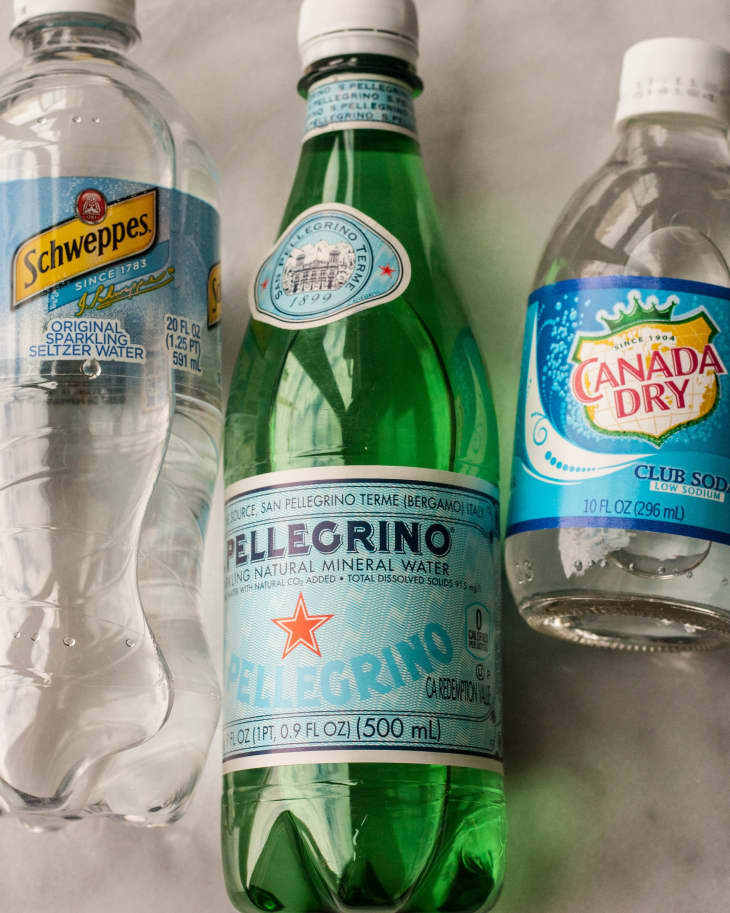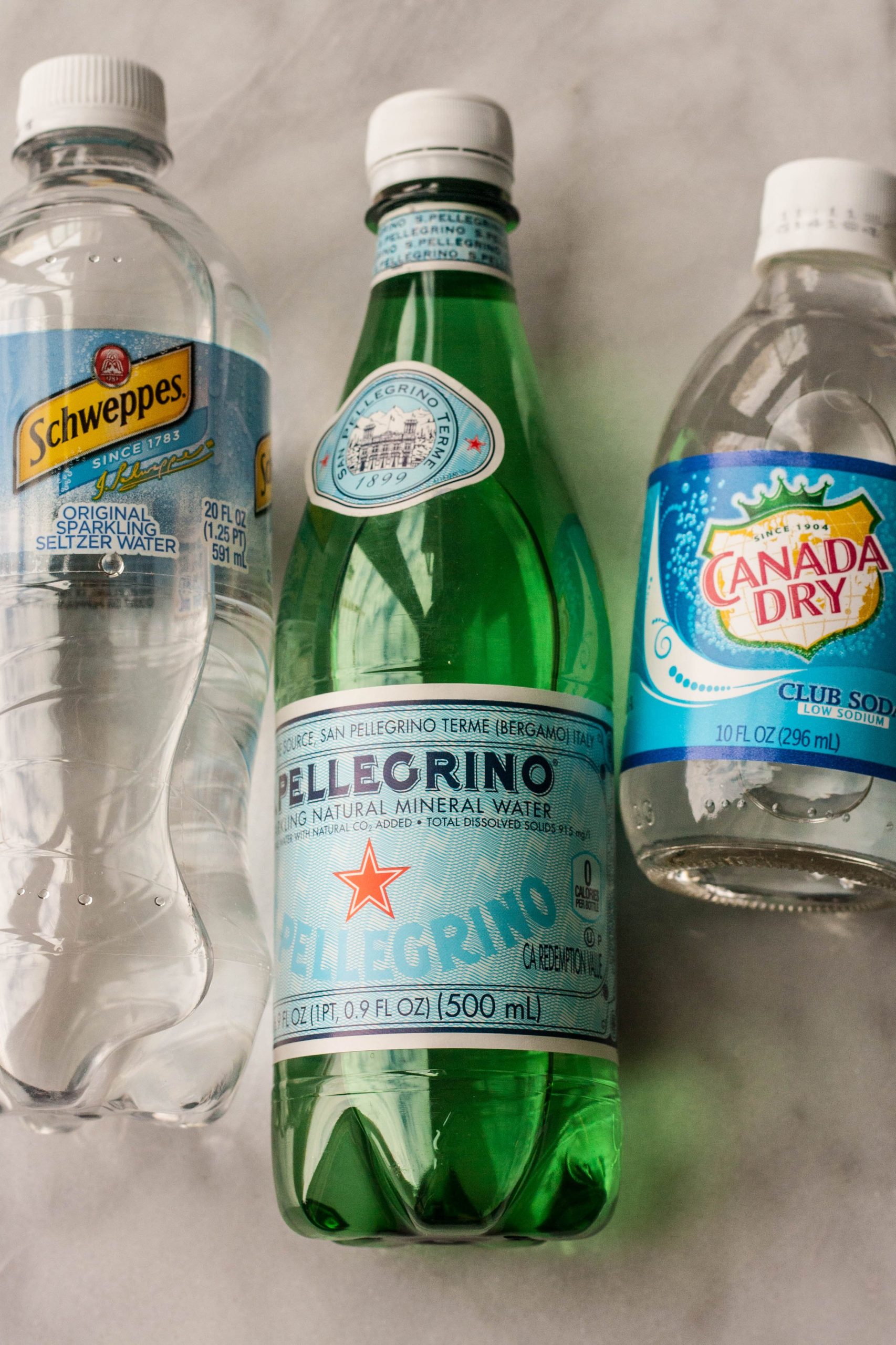Club soda contains added minerals and sodium, while sparkling water is carbonated naturally or artificially without additives. Club soda often includes potassium bicarbonate and potassium sulfate for taste enhancement.
Understanding the subtle differences between club soda and sparkling water can enhance your culinary experiences and inform your beverage choices. Club soda, a favorite mixer for cocktails, brings an intentional flavor profile to drinks with its mineral content. On the other hand, sparkling water offers a purer form of carbonation, making it a go-to for those seeking the effervescence without the added taste.
Choosing between the two comes down to personal preference, whether you’re crafting a cocktail or simply seeking a refreshing alternative to still water. Being aware of these nuances not only guides you in recipe precision but also helps tailor your beverage selection to match your dietary preferences and needs.

Fizzing Up The Basics
Ready to dive into the world of fizzy drinks? This bubbly adventure uncovers the subtle differences between club soda and sparkling water. Both pack a punch with their effervescence, often leaving us refreshed and satisfied. Yet, their unique qualities set them apart. Let’s get to know each one and discover which might be the MVP of your next thirst-quenching session.
Defining Club Soda
Club soda is a popular go-to for mixologists and casual sippers alike. What’s in it? Manufacturers infuse carbon dioxide into water under high pressure, creating that familiar fizz. But wait, there’s more. They add minerals like sodium bicarbonate and potassium sulfate. Why? They enhance flavor and are sometimes credited with tenderizing cocktails. Often, club soda is a wingman in mixed drinks, adding zest without overpowering the main flavors.
Defining Sparkling Water
Now, let’s talk about sparkling water, often called ‘seltzer’ or ‘carbonated water.’ Its story is simple and straightforward. Carbon dioxide gives it bubbles without added minerals. Less in ingredients, versatile in use. Sparkling water is like a blank canvas for your palate, complementing both sweet and savory flavors. Perfect solo or in a fruity mocktail. Sparkling water lets the accompanying flavors shine.
| Feature | Club Soda | Sparkling Water |
|---|---|---|
| Carbonation | Added CO2 | Added CO2 |
| Minerals | Added for flavor | None or naturally occurring |
| Use | Mixes in drinks | Versatile, perfect alone |
- Bubbles: Both contain added carbonation for that satisfying tingle.
- Taste: Club soda brings a subtle mineral taste, sparkling water stays neutral.
- Use: Club soda is a cocktail’s friend; sparkling water stands proud on its own or in non-alcoholic drinks.

Seltzer’s Standing In The Fizzy Family
Ever wondered about the bubbles in your drink? Let’s dive into the fizzy family and place seltzer among its sparkling relatives.
What Is Seltzer?
Seltzer is a drink full of bubbles. People enjoy it as a refreshing beverage. It is plain water that has been carbonated. This means CO2 gas is added under pressure.
It has no added minerals. This makes it different from other bubbly waters. The name comes from a German town, Selters, known for natural springs.
Seltzer Vs. Sparkling Water
Seltzer and sparkling water both have bubbles. But they are not the same thing. Sparkling water comes from a natural source and has minerals. Seltzer is made by humans and is just carbonated water.
| Seltzer | Sparkling Water |
|---|---|
| Carbonated tap water | Carbonated natural water |
| No added minerals | Has natural minerals |
| Made artificially | Often bottled at the source |
Seltzer is often preferred for mixing drinks. Sparkling water, on the other hand, may have a subtle taste due to its minerals.
Carbonation: The Bubbly Science
Understanding the fizz in your sips could unlock a world of bubbly bliss. Sparkling water and club soda both dance on the tongue with a tickle of bubbles. This magic comes from a process called carbonation. Let’s dive into this fizzy science to appreciate these effervescent drinks fully.
How Carbonation Works
Carbonation is the infusion of carbon dioxide (CO2) into liquid. This creates those delightful little bubbles known as effervescence. Here’s how it happens:
- CO2 gas is forced into water under high pressure.
- The gas dissolves because of the pressure and cold temperatures.
- Once bottled, the gas stays dissolved until you open it.
- Opening the bottle releases pressure, allowing bubbles to form.
Effects Of Carbonation On Flavor
Ever wonder why fizzy drinks taste different? Carbonation changes water’s acidity, giving it a slight tang. That zesty bite in sparkling water or club soda isn’t just fun; it can alter taste:
| Attribute | Effect of Carbonation |
|---|---|
| Brightness | Carbonation can enhance flavors, making them seem crisper. |
| Acidity | It introduces a mild tartness, which can be refreshing. |
| Aftertaste | The bubbly sensation reduces lingering sweetness or bitterness. |
Understanding carbonation adds depth to the simple joy of effervescent drinks. Next time you enjoy a carbonated beverage, savor the science in every sip.
From Minerals To Mixers
Exploring the bubbly world of sodas and sparkling waters reveals fascinating differences. From Minerals to Mixers, these carbonated drinks sparkle in unique ways. Dive into the effervescent details and uses of club soda and sparkling water right here.
Mineral Content Differences
Club soda and sparkling water tantalize the tongue with their fizz. Yet, they differ in mineral composition. Manufacturers inject club soda with minerals intentionally. These minerals typically include sodium bicarbonate, potassium sulfate, and disodium phosphate, giving club soda its distinct taste. On the other hand, sparkling water comes from natural springs or wells, inheriting minerals from the earth. It contains varying levels of minerals based on its source, offering a more natural flavor interpretation.
| Drink Type | Added Minerals | Source |
|---|---|---|
| Club Soda | Yes, includes sodium bicarbonate, potassium sulfate, etc. | Artificial or natural water with added minerals |
| Sparkling Water | No, minerals come from the source | Natural springs or wells |
Popular Uses In Beverages
Have you ever wondered how bubbly beverages get their kick? Club soda and sparkling water are prime mixers in the drink industry. Club soda, with its neutral flavor, pairs well with spirits in cocktails, augmenting flavors without overpowering them. Think of a classic gin and tonic or a whiskey soda. Sparkling water delights as a hydrating, standalone beverage often infused with natural fruit essences. It’s also a base for fruit spritzers and is favored in mocktails for a lively zest without added calories or sugar.
- Club Soda: Perfect for cocktails
- Sparkling Water: Ideal for hydrating and light, fruity beverages
Health Considerations In Carbonated Drinks
Exploring the world of carbonated drinks reveals a subtle yet significant difference between club soda and sparkling water. While both bring the fizz and bubble that many love, their impact on health is a topic of interest for conscious consumers. This section dives into the key health considerations when enjoying these bubbly beverages.
Hydration And Health
Staying hydrated is vital for overall well-being. Carbonated waters can contribute to daily fluid intake. Club soda and sparkling water both hydrate, just as regular water does. Yet, added ingredients in club soda, like sodium, may require attention from those monitoring their salt intake. Here’s a quick look at their hydration benefits:
- Sparkling water: Pure and simple hydration
- Club soda: Hydrating with a sodium component
Dental Health And Bone Density
Carbonation can affect dental health. The acid in carbonated drinks might contribute to enamel erosion. Sparkling water tends to have lower acid levels than club soda, making it a better choice for teeth. As for bones, some believe carbonation can leach calcium from bones. Research is mixed, but moderation is key. Highlights include:
| Drink Type | Dental Health | Bone Health |
|---|---|---|
| Club Soda | Potential for more enamel erosion due to additives | Generally safe in moderation |
| Sparkling Water | Less acidic, better for dental health | Generally safe in moderation |

Choosing Your Bubbles
When it comes to effervescent beverages, club soda and sparkling water are popular choices. But not all bubbles are created equal! Think of a balloon: some pop loudly, others with just a hiss. That’s how these fizzy drinks differ, and choosing which to pour into your glass hinges on a few considerations.
What To Consider
Flavor and Ingredients:
Club soda often includes added minerals like sodium bicarbonate or potassium sulfate. These give it a slightly salty taste. Sparkling water, on the other hand, is pure water carbonated with added fizz for that tickle on your tongue.
Use in Mixology:
If mixing drinks is your art, club soda’s mineral content can enhance certain flavors. For a purer base that lets other ingredients shine, choose sparkling water.
Health Benefits:
As a plain option, sparkling water edges out for those monitoring sodium intake. But remember, always check labels, as some brands might surprise you with their content.
Sustainability And Environment Impact
Both beverages come in various packages, but environmental footprint varies. Glass bottles often mean a lower impact than plastic, as they can be reused or recycled more effectively.
| Packaging Type | Club Soda | Sparkling Water |
|---|---|---|
| Plastic Bottles | Less eco-friendly | Less eco-friendly |
| Glass Bottles | Better for reuse and recycling | Better for reuse and recycling |
| Aluminum Cans | Recyclable, lower carbon footprint | Recyclable, lower carbon footprint |
Choosing a sustainable brand that prioritizes eco-friendly practices is key. Look for those committed to water conservation, carbon footprint reduction, and responsible packaging.
Remember too, home carbonation systems can turn tap water into a fizzy delight while cutting down on waste. A small investment leads to a greener footprint and endless bubbles at your fingertips!
Frequently Asked Questions On Difference Between Club Soda And Sparkling Water
Is Club Soda The Same As Sparkling Water?
Club soda is not the same as sparkling water. Both have carbonation, but club soda contains added mineral-like ingredients for taste, often including sodium bicarbonate and potassium sulfate. Sparkling water, meanwhile, is naturally carbonated spring or well water.
Can You Drink Club Soda As Regular Water?
Club soda can be consumed like regular water, but with consideration for its added minerals and sodium content. It’s best enjoyed in moderation, especially for those monitoring their sodium intake. For regular hydration, plain water is preferable.
Does Sparkling Water Hydrate As Well As Still Water?
Yes, sparkling water hydrates the body as effectively as still water. Despite its fizziness, the carbonation does not affect hydration levels. It’s a suitable alternative for those desiring a bubbly twist to their regular water intake.
Are There Health Benefits To Drinking Sparkling Water?
Sparkling water offers similar health benefits to still water, such as hydration and aiding digestion due to its carbonation. However, it lacks the added minerals found in club soda, which can have additional nutritional benefits.
Conclusion
Understanding the nuances between club soda and sparkling water can elevate your beverage choices. Each offers a distinct taste and composition, suitable for different occasions. Opt for club soda in your next cocktail or reach for sparkling water for a hydrating fizz.
Choose wisely to quench your thirst or lift your spirits!

